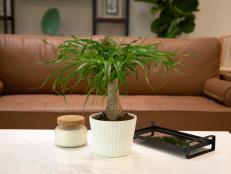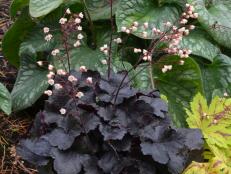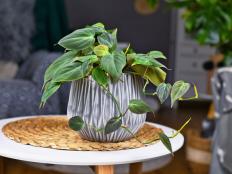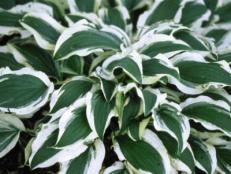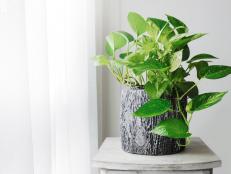Dracaena Plant Care
Dracaena houseplants are easy to care for with our experts' planting and growing tips.


Shutterstock/Elizabeth Fernandez
Dracaenas have beautiful colors and patterns and are popular as houseplants. They can also be grown as annuals in gardens where the winters are warm. D. fragrans, shown here, may have solid green or variegated leaves and will mature at 15 to 50 feet tall.
What Is a Dracaena Plant?
Grown for their attractive foliage, dracaenas are popular plants that need very little care. There are over 100 species of dracaena trees and succulent shrubs, although many are used as houseplants because they're easy to grow and tolerate low light. Hardy in USDA Zones 10 and 11, these tropicals, which are in the Dracaena genus and the asparagus family, are great for adding structure to outdoor gardens, too. In cold regions, they're treated as annuals.
According to research conducted by NASA, dracaenas can clean benzene, carbon dioxide, formaldehyde and trichloroethylene from indoor air. However, they're toxic to companion animals like dogs and cats and should be kept out of their reach.
How to Plant a Dracaena
To grow dracaenas as houseplants, plant them in good quality potting soil and give them a location that gets bright, indirect light. Avoid direct light, which can burn their leaves.
These plants are usually happy in average home or office conditions, but if you see their leaf tips turning brown, that's often a sign that the humidity is too low. Mist your plant regularly with water from a spray bottle or put it on top of some pebbles in a saucer filled with a little water. Don't let the roots touch the water, which can cause them to rot. As the water evaporates, it will add humidity to the surrounding air.
Water when the top inch of soil feels dry to the touch, and fertilize your plant with a balanced houseplant fertilizer, following the directions on the label for how often and how much to apply. In general, feed every other week in spring and summer. Cut back to once a month in the fall and don't feed during the winter, when the plant should be allowed to go relatively dormant.

ProvenWinners.com
Hardy in USDA Zones 7 to 11, Dracaena indivisa 'Spikes' grows 2' to 3' tall in garden beds and needs part sun to sun.
Dracaenas grown in the garden need warm temperatures, as you'd expect from plants that are native to the tropics. They'll succumb to frost, but if you get an occasional cold snap, you may be able to save your dracaena by covering it temporarily. Be sure to remove the cover when the temperatures warm back up.
Dracaenas aren't picky about outdoor soil, as long as it drains easily. However, they'll grow best in garden soil amended with compost or other organic matter. Like dracaenas grown as houseplants, they can't take direct sun.
How to Prune Dracaenas
Some dracaenas can grow quite tall, but they're easy to cut back when needed. For best results, prune your plant when it's actively growing in the spring or summer and use a sharp, clean knife or pruners. It's a good idea to dip the blade in a little bleach and water before you make the cuts, to be sure it won't transmit any plant diseases.
When you prune, cut the dracaena stems, which are called canes, at an angle. Also, remove any injured or damaged canes and dead or dying leaves.
Start a new dracaena plant by inserting the cut cane into a pot of moist sand or a glass of water placed in a brightly lit window. When roots form in the water, plant the cane in a container of potting soil.
Popular Dracaenas to Grow
- Dracaena fragrans, or corn plant. Also called mass cane, this slow-growing plant is easy to care for and adapts well to a variety of conditions. Depending on the variety, D. fragrans may have solid green or variegated leaves and mature at 15 to 50 feet high. Hardy in USDA Zones 10 to 12, corn plants can take light shade or indirect sunlight. Keep them moderately moist and give them well-draining soil.
- Dracaena relfexa 'Variegata' or 'Song of India.' This dracaena can grow to 18 feet tall and spread up to 8 feet across. However, it's a low-maintenance houseplant and usually tops out at three feet tall in containers. The leaves are multicolored with green centers and yellow or cream margins; as they mature, they become more yellow.
- Dracaena deremensis 'Janet Craig.' This plant has glossy, solid green leaves and can tolerate neglect. Give it low to medium light and well-drained, evenly moist soil. 'Compact Janet Craig' grows just 4" to 6" tall while the original can grow to a foot or more.
- Dracaena sanderiana, or lucky bamboo, isn't a bamboo despite its name. Its young stems can be woven or braided into various shapes. It can be grown in water or in a container of gravel filled with water.
- Madagascar dragon tree, Dracaena marginata, has dark green, strappy leaves with a narrow band of dark red around the margins. Dragon tree stems can be braided together or allowed to grow as separate stems in one pot.
Buy Dracaena Plants
Dracaena Pests and Diseases
Dracaenas are relatively pest-free. Fungus gnats can be a problem if they're planted in soil that contains compost or bark, so use a potting or planting soil without these elements to help prevent them.
Scale, aphids, thrips and mealybugs are pests that sometimes suck sap from dracaena leaves, weakening the plants and even killing them. Check underneath your plant's leaves, along its trunk and at its base for these kinds of insects.
Mealybugs look like white, fuzzy or cottony masses. Try blasting them off with a strong spray of water from the sprayer at your kitchen sink, or, if your plants are outside, from the garden hose. You can also use a cotton ball or cotton swab dipped in rubbing alcohol to wipe them off. Rinse your plant with clean water when you are finished.
Aphids can be green or black in color, with round, translucent bodies. They cause leaves to yellow and often leave a sticky secretion on your plants. Wash them off with a cloth dipped in soapy water or apply an insecticidal soap.
Scale are small tan, dark brown or white pests with waxy coverings. Natural predators like ladybugs and parasitic wasps can help control them on outdoor plants. For indoor plants, use an old toothbrush dipped in soapy water to scrape them off. If scale persists, apply a horticultural oil or insecticidal spray, following the product's directions.
Spider mites are too small to see without a magnifying glass but suspect they are present if you notice a lot of small brown or yellow spots on your dracaena's leaves, especially during warm weather. You may see their eggs underneath the foliage. Try spraying spider mites off with water. If that doesn't control them, apply a miticide, following the label directions.
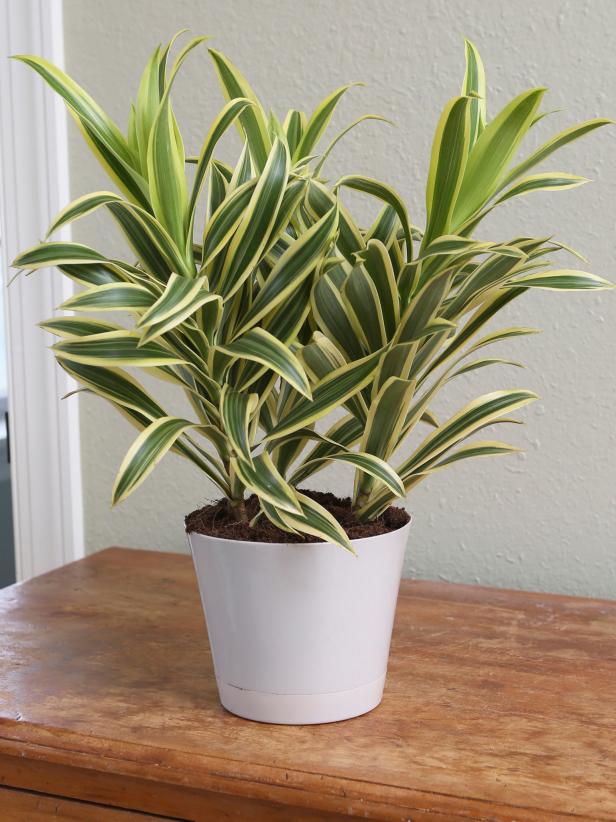
Costa Farms
If you see webs on your dracaena and the leaves look discolored and/or curl and drop off, spider mites are the likely cause. Knock the mites off with a gentle spray of water from the kitchen sink or put big plants in the shower. If the pests keep coming back, use an insecticidal soap or neem oil. Shown here: Dracaena 'Song of India'
Thrips, small, winged insects, can also damage dracaenas. They can also be washed away with a stream of water, and badly infested leaves should be cut off. Avoid feeding your plant with a fertilizer high in nitrogen, which often results in a lot of tender, new growth that attracts these pests.
What causes leaf spots on corn plants?
Dracaenas aren't often attacked by disease, but they can suffer from soft rot and fusarium leaf spot.
Leaf spot can appear for a number of reasons, such as poor air circulation, overwatering, inconsistent watering or high humidity. Likewise there are several potential culprits, including fungal disease, bacteria, insects and poor growing conditions.
Leaf spot caused by pathogens occur most often on young dracaena leaves. As they become larger, the spots turn reddish-brown or tan with yellow halos. Spots can also be as small as pinpoints.
To help prevent fungal diseases, water dracaenas at the base and avoid getting water on their foliage. Leaf spot can be treated with a fungicide, but it can be contagious, so isolate your plant until it's healthy again. If your dracaena has soft rot, and it looks and smells like it's rotting, go ahead and discard it. Soft rot can't be cured.
Don't put any plant parts that show signs of disease or pests in your compost pile, where problems can spread.
Removal of spotted leaves is important. Also remove any fallen leaf litter within the plant's interior and on the soil surface since this decaying material can harbor diseases and pests. Take a good look at the soil. If the soil is too wet, let it dry out completely before watering again. If the soil is too dry, give it a good drink. Keeping plants sufficiently watered helps to keep them healthy. Instead of watering on a set schedule, water only when the soil begins to dry out. Drain any saucer or tray you're using under your plant so it won't stand in excess water.
If you notice brown spots on the tips and edges of leaves, this could be a sign of excess salts, chlorine or fluoride in the water. Avoid using tap water if possible; instead use rainwater or distilled water. If you prefer tap water, allow it to sit for at least 24 hours so that the chlorine and fluoride can evaporate. Also, if you notice an accumulation of white deposits on the outside of the pot (especially near the drainage holes), this is a sign of excess salts. Use rainwater or distilled water to flush out excess salts.
When you buy new plants, look them over thoroughly or quarantine them for a few days to be sure they’re pest-free before bringing them home. Check outdoor plants carefully before moving them indoors, so no unwanted hitchhikers come with them.









